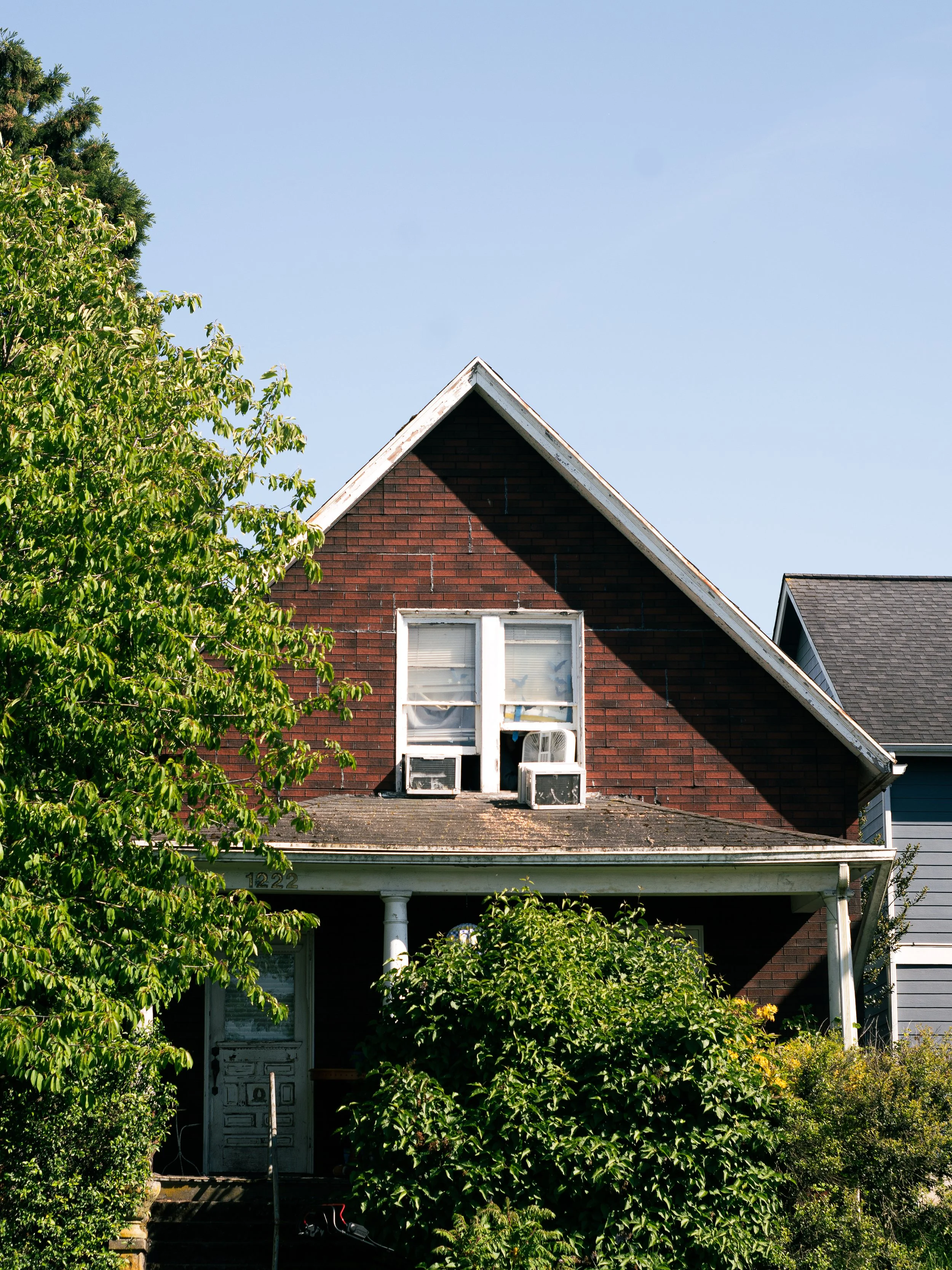A Toasty Future
The increase in heat waves, health risks and houselessness in Washington
Panorama of beautiful Bellingham Bay.
Story by Cassie Mullin // Photos by Gareth Miller
July 7, 2025
The first sunny day in Washington state means every lawn is flooded with people rather than rain. Warm beams creep through the branches above, shining down on the sudden abundance of hammocks, picnic blankets and bare feet. No thought of cooling off crosses the minds of those basking in the long awaited sunshine.
However, the sun does not discriminate. Increasing temperatures can be a hurdle rather than an opportunity for vulnerable communities. Those same warm beams shine down on pre-existing health conditions, unhoused individuals and neighborhoods with squeaky box fans in lieu of central cooling systems.
Mother nature does not pick and choose who has the means to defend against her.
Washington is expected to experience an increase in the duration and frequency of heat events and it’s beginning to make everyone sweat. The data is primarily focused towards warming on the global scale, but there are localized statistics that climatologists are keeping on the radar.
This is critical for coastal regions that have more umbrellas than air-conditioning units and a large population of people who don’t have access to either.
This impending phenomenon affects the planet, with all its environments and ecosystems; the power, the governments who control those environments, and the people who live in and under both.
Western Washington is locationally lucky when temperatures begin to rise because coastal cities are neighbors to one giant air-conditioner — the Pacific Ocean. This large body of water cools winds coming from the west, pushing moderate temperatures across land until the winds are intercepted by the Cascades, where they lose moisture and move into the eastern side of the state.
While some places in eastern Washington, like the Methow Valley, have the rivers to moderate their temperatures, residents in the southeastern region brave hot and dry conditions.
“We’re still kind of tucked in the mountains,” said Ruth Payne from Aero Methow Rescue Service, a company that provides emergency medical care. “So thankfully we stay a little less [hot], but it still definitely does get warm.”
The mountains provide a forcefield for people like Payne, comparable to the forcefield the Pacific creates over the western region.
In June 2021, the Pacific Northwest was hit with an extreme heat wave that shattered long-standing high temperature records with fury. Infrastructure buckled, crops were ruined and over 500 deaths were attributed to this event.
This event was produced by a heat dome, a lid of cold air trapping hot air over a region and preventing it from dissipating. It was an unusual combination of atmospheric conditions that perfectly set the Pacific Northwest up for disaster.
While climate change may not be the sole factor behind the heat wave, Washington’s state deputy climatologist, Karin Bumbaco, says that it is an undeniable influence.
“What was happening in the weather pattern is what we expect to see during [western] heat waves,” Bumbaco said. “But we like to say that climate change is a contributing factor in every heat wave.”
Climate change is the long-term shift in weather patterns that can occur naturally, but has been expedited by human activities, such as the burning of fossil fuels, since the 1800s. Overall, global warming can always be attributed to climate change, Bumbaco says, while extreme events multiply the already proposed threat.
The complexity of these relationships makes it tricky for scientists to encapsulate environmental information.
“I think good scientists are trying not to call wolf about all this stuff,” said Andrew Bach, a climatology professor at Western Washington University.
Bach said that climatologists must be attentive to data when providing insight on weather patterns. Although he has seen evidence of warming on the landscape, retreating glaciers and more warm-weather species in the mountains, identifying how climate change will transform an area is difficult and complex.
“This is the problem in understanding and communicating about climate change," Bach states. “We have some pretty good ideas on trends, but it’s a complicated system.”
The trends are showing that Washington is expected to experience an increase in average temperatures and an increase in the duration and frequency of extreme heat events..
The Climate Impact Group at the University of Washington predicts that by 2050 there will be between 17 and 27 extreme heat days, above 90 degrees Fahrenheit, for the western portion of the state, and between 20 and 30 for the eastern part of the state each year.
The 2021 heat dome is the deadliest weather-related event to strike Washington, revealing places where city resources are needed to better adapt to extreme heat.
But this heat wave provides an example to learn from and showed us how devastating climate change can be, according to Nature Communications, an academic journal that covers the natural sciences.
“The most important thing to understand is that [nearly] all deaths in a heat wave are potentially preventable,” Kristie Ebi, a core faculty member of the Center for Health and Global Environment at the University of Washington, said.
Ebi has been conducting research on the health risks of climate variability for 25 years. She has supported multiple countries in assessing vulnerabilities and implementing adaptation policies and programs.
The World Health Organization warns that “the negative health impacts of heat are predictable and largely preventable with specific public health and multi-sectoral policies and interventions.”
Both individuals and local governments struggle to grasp the severity of extreme heat, Ebi said.
“People typically don’t consider heat a killer, and yet it does,” Ebi said. “Even health care providers may not realize the extent to which heat is such a danger, so better education is critically important.”
Extreme temperatures put stress on multiple organ systems and can lead to heat-related illnesses like heat stroke and heat exhaustion. Symptoms such as dizziness, weakness and, in extreme cases, unconsciousness are dangerous for anyone. But a long list of social groups are particularly vulnerable to heat: Older adults and young children, outdoor workers and people with underlying health conditions are just a few of these.
Certain medications — including antidepressants — make it difficult to regulate body temperature, according to the Environmental Protection Agency, which also notes that heat-related deaths are most commonly reported among adults 65 and older.
In addition to vulnerable people, people reside in vulnerable places. Low-income neighborhoods, communities of color and unhoused populations are at a higher risk during heat events because they experience a systemic deprivation of social and material resources.
Air conditioning provides an example of how inequalities manifest across Washington's unaccustomed social and physical infrastructure. People who cannot afford air conditioning are more likely to suffer from unsafe temperatures.
Although it is one of the safest ways to regulate body temperature and recommended by multiple sources as a way to beat the heat, not everyone has access. The Climate Impacts Group points out that only 34% of households that earn $50,000 or less across the three most populated counties — King, Pierce and Snohomish — have AC units.
Air conditioning units spilling out of a house on Garden Street.
Low-income families, or people experiencing any degree of vulnerability, can visit the Opportunity Council if they are local to Bellingham, Washington. The non-profit is a community resource that connects people with childcare resources, basic necessities, housing assistance and similar services.
The council’s Home Electrification and Appliance Rebates Program, funded by Washington’s Climate Commitment Act, helps mitigate the costly burden of air conditioning by working with clients to install energy-efficient heat pumps.
Heat pumps can be used as both an air conditioning unit and a furnace, transferring heat outside when it's hot and bringing it in when it’s cold.
For individuals experiencing houselessness, public spaces may be the only regulated temperatures for them to escape to.
“We live in a climate that is so unpredictable,” Sabrina Mossor, a youth social worker from Olympia, Washington, said.
Mossor has encountered many nonprofits and shelters on behalf of the youth she works with, as well as in her personal experience with homelessness.
“It’s really hard. The elements play a huge part in the dysregulation of people who are experiencing [houselessness],” she said. “Not only do they not have shelter, but also they don’t have a way to regulate themselves.”
In downtown Bellingham, the Lighthouse Mission’s Base Camp opens its doors to guests seeking out emergency overnight shelter or family shelter, as well as health programs, meals and hygiene services.
The 211 website, a free and confidential community service provided by the state, marks Base Camp as a cooling center during extreme heat events.
Washington residents may also dial 211 at any time to connect with local services that range from emergency weather shelters to food to crisis intervention.
"The Light House Project" bus parked with the sun shining in the background.
Unfortunately, public services like these often face adversity with cuts to funding and overcrowding.
Similar to extreme heat on people’s organ systems, these factors put excess stress on neighborhood communication networks, making the spread of information more complex than it already is.
“Where are you going to set up the cooling shelters? What’s the capacity? Are they open overnight?” Ebi said. “If they’re going to be open overnight, do people bring their pets? Are [they] going to offer a free bus transport, which means [people] have to walk to the bus to go to the cooling center? How do you get that information out?”
Cities and counties often support residents by offering online information, radio broadcasts, television alerts or social media posts about extreme weather. But with a large population of people who might not have access to any of those, the limitations are considerable.
The “awareness of the risks, awareness of available resources and access to these resources [are] not sufficient for the people these resources are designed for,” according to the International Society for Environmental Epidemiology, a scientific association that studies the effects of environmental exposures in people.
As the sun sets on Washington state, hammocks get rolled tightly and picnic blankets are stuffed back into bags.
Some of the day’s warmth will be picked up by squeaky box fans, trapped inside homes and circulated back. Scientists and local governments will continue their work to protect the Pacific Northwest from the warmth they are trapped within.



